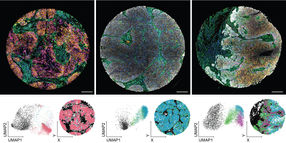Major advances made in predicting crystal structures
Findings of international test have implications for pharmaceutical development
Researchers have met the challenge of predicting the crystal structures of small organic molecules by computational methods without experimental input, a goal that has been described as the Holy Grail of crystallography. This breakthrough was achieved in the 4th blind test of crystal structure prediction, an exercise conducted by an international group of fifteen research groups that was organised by the Cambridge Crystallographic Data Centre (CCDC) and the University of Cambridge.
Crystal structures describe the periodically repeating arrangement of molecules in a material and determine many of a material's properties, such as solubility, dissolution rate, hardness, colour and external shape. The ability to predict crystal structures could thus revolutionise the design of materials with novel properties.
In particular, the pharmaceutical industry would gain huge benefit from reliable methods of crystal structure prediction because pharmaceutical molecules are prone to crystallise in more than one crystal structure (or polymorph), depending on the conditions under which the molecule is crystallised. The specific polymorph that goes into a formulation must be strictly controlled to ensure consistency of delivery to the patient.
Many approaches to the problem have been developed and these have been evaluated over the years in international exercises, known as the blind tests of crystal structure prediction. Fifteen research groups who have been developing methods for predicting crystal structures of organic molecules took part in the latest test, in which participants were challenged to predict four recently determined crystal structures given only the chemical diagram of the molecules and conditions of crystallisation, with three predictions allowed per crystal.
The results of previous blind tests, in 1999, 2001 and 2004, demonstrated that the crystal structures of small organic molecules can occasionally be predicted under favourable conditions, but the rates of success were low and no one method was consistently successful over the range of types of molecules studied.
The results of the 2007 blind test represent a dramatic improvement over what has been achieved previously: 3 groups had one experimental structure within their three allowed predictions, 3 others had two such hits and one group predicted all four target crystal structures, each as their most likely prediction. These very successful results were obtained by Dr Marcus Neumann of Avant-garde Materials Simulation and Drs Frank Leusen and John Kendrick of the Institute of Pharmaceutical Innovation at the University of Bradford.
Dr Graeme Day, of the University of Cambridge, who co-ordinated this year's challenge said: "The results of this year's test reflect significant development over the past few years. Things looked much less encouraging last time we held a blind test, but crystal structure prediction can now be seen as a real tool to be used alongside experimental studies, when designing new materials or developing a pharmaceutical molecule."
The whole problem is not solved - the blind tests are limited to small, relatively rigid molecules - but these recent results demonstrate a significant advance in the field. The method can now be viewed as applicable to a number of problems of importance in the pharmaceutical industry and more generally to improving our understanding of how molecules are held together in crystalline solids.
Most read news
Other news from the department science

Get the analytics and lab tech industry in your inbox
From now on, don't miss a thing: Our newsletter for analytics and lab technology brings you up to date every Tuesday. The latest industry news, product highlights and innovations - compact and easy to understand in your inbox. Researched by us so you don't have to.
























































